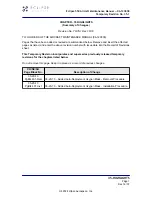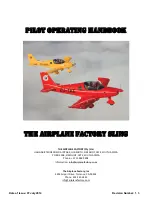
Owners Manu
al
XIX FORM 3
WARNING!
Disclaimer !
Use of this paraglider is entirely at your own risk. Any modifications
(including adjustments to the
brakes)
, improper repairs or failure to carry out annual inspections will
void the glider’s certificate
of airworthiness
. All pilots are responsible for their own safety and must perform on-site safety checks
before every launch. Launching is only permitted if the pilot is certain that the glider is airworthy. Pilots
must find out about regional and local weather conditions and should only fly when current conditions
and forecasted developments allow safe flying. The glider may only be flown by pilots who hold a valid
pilot’s licence or who are under the supervision of a certified paragliding instructor. The manufacturer,
retailers and all third parties accept no liability whatsoever.
The paraglider must only
be used:
if the pilot is in good healthy, fit to fly with body and mind
if the pilot has sufficient education, experience and training
if the pilot is able to do all the intended maneuvers descriebed and recommended in this manual
if the pilot’s take-off weight is correct for the glider
with the correct tecnical condition equipment checked before each flight (wing, seat, reserve, hel-
met, boots etc.)
if there is no rain or snow
in save weather conditions
under visual meteorological conditions VMC (not in cloud, fog or mist), considering the national and
international roules of law and workmanship.
in flying sites clear of dangerous obstacles, big enough to abort take off procedure
for winch launching with certified winches and licensed instructors
All use of the paraglider outside of this behaviour brings a much bigger risk of accident.
(including adjustments to the
(including adjustments to the
void the glider’s certificate
. All pilots are responsible for their own safety and must perform on-site safety checks
before every launch. Launching is only permitted if the pilot is certain that the glider is airworthy. Pilots
must find out about regional and local weather conditions and should only fly when current conditions
and forecasted developments allow safe flying. The glider may only be flown by pilots who hold a valid
pilot’s licence or who are under the supervision of a certified paragliding instructor. The manufacturer,
if the pilot has sufficient education, experience and training
if the pilot is able to do all the intended maneuvers descriebed and recommended in this manual
if the pilot’s take-off weight is correct for the glider
with the correct tecnical condition equipment checked before each flight (wing, seat, reserve, hel-
under visual meteorological conditions VMC (not in cloud, fog or mist), considering the national and
if the pilot is able to do all the intended maneuvers descriebed and recommended in this manual
with the correct tecnical condition equipment checked before each flight (wing, seat, reserve, hel-
with the correct tecnical condition equipment checked before each flight (wing, seat, reserve, hel-
under visual meteorological conditions VMC (not in cloud, fog or mist), considering the national and
All use of the paraglider outside of this behaviour brings a much bigger risk of accident.
under visual meteorological conditions VMC (not in cloud, fog or mist), considering the national and
under visual meteorological conditions VMC (not in cloud, fog or mist), considering the national and
4





































